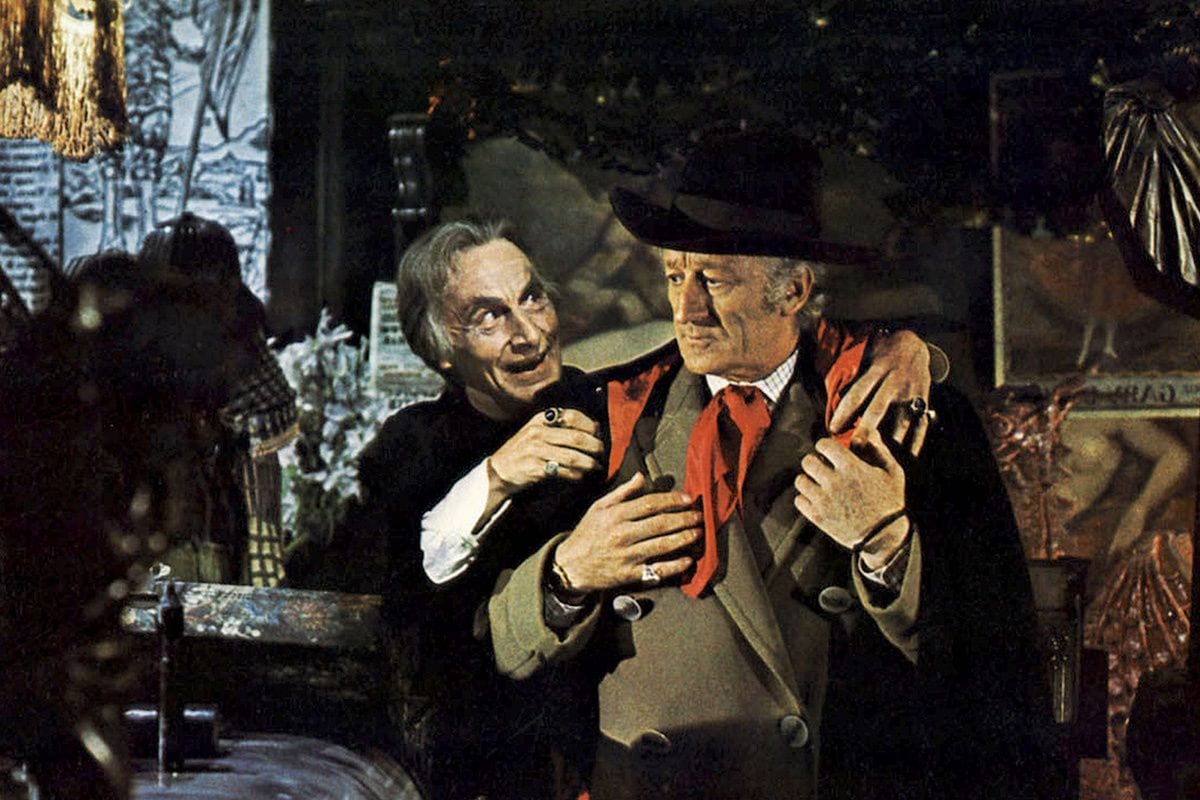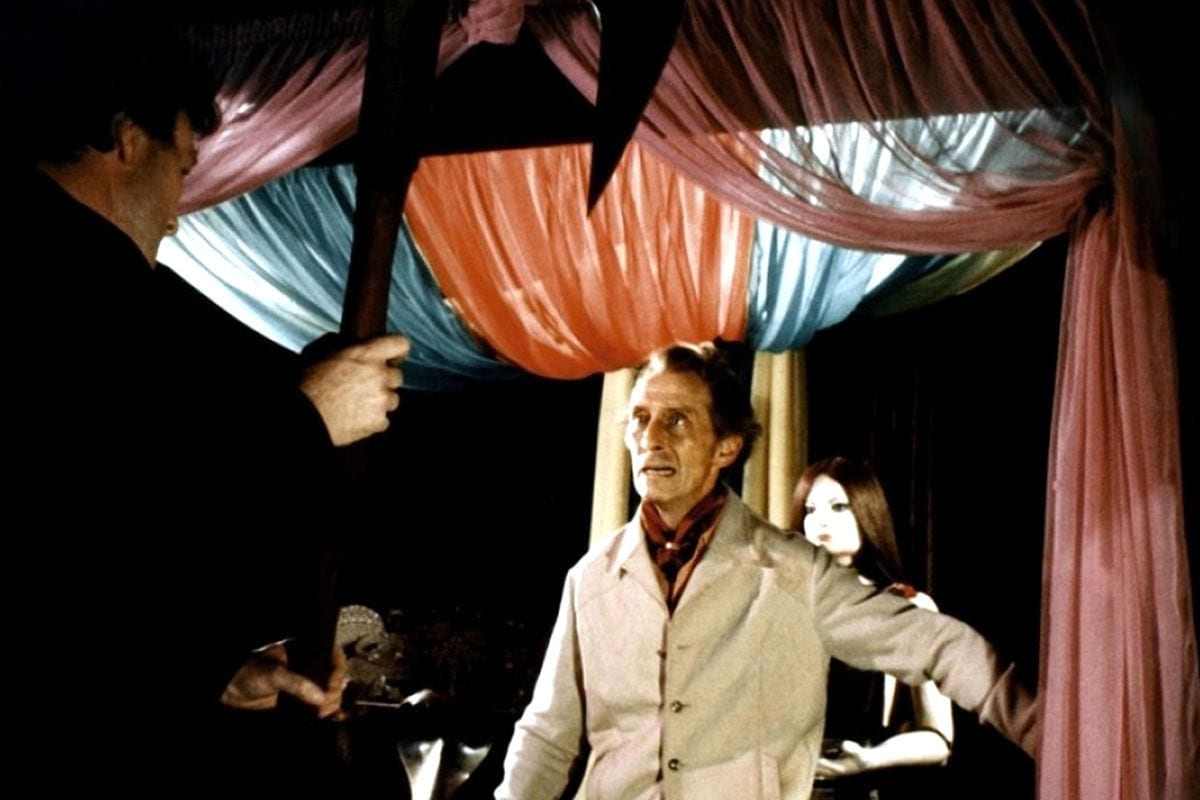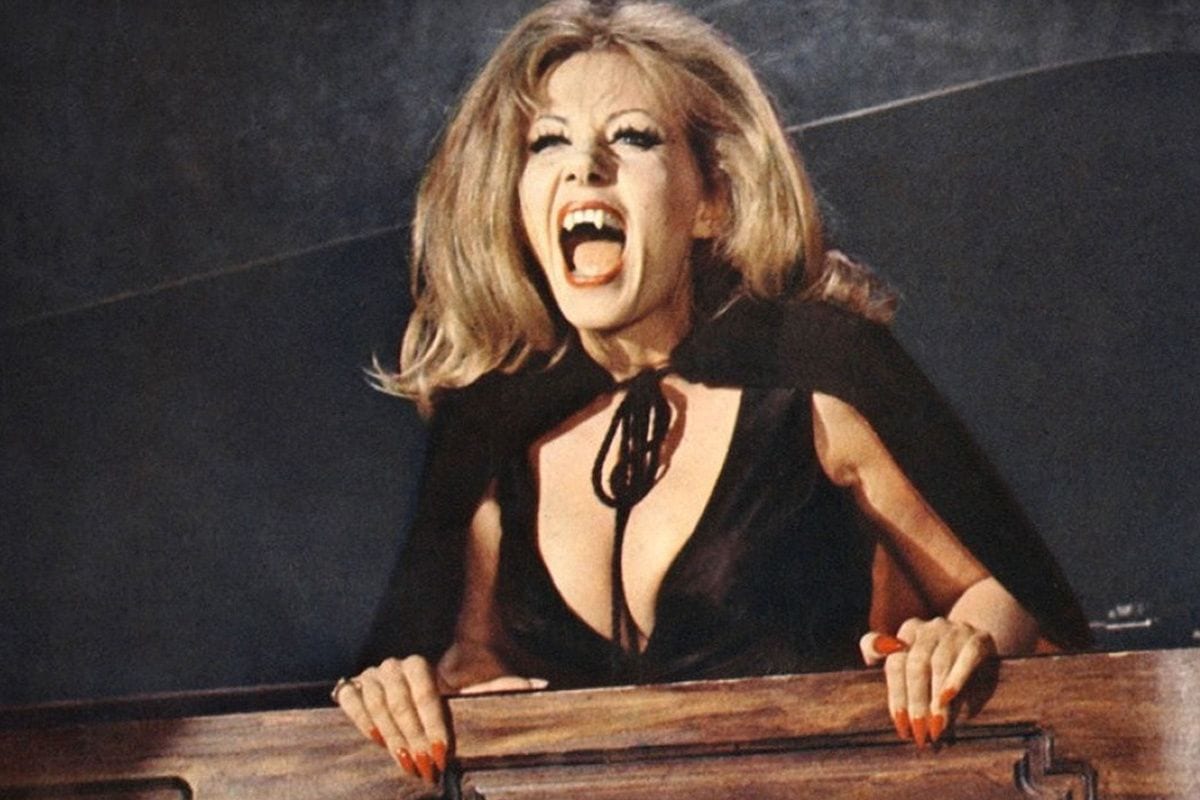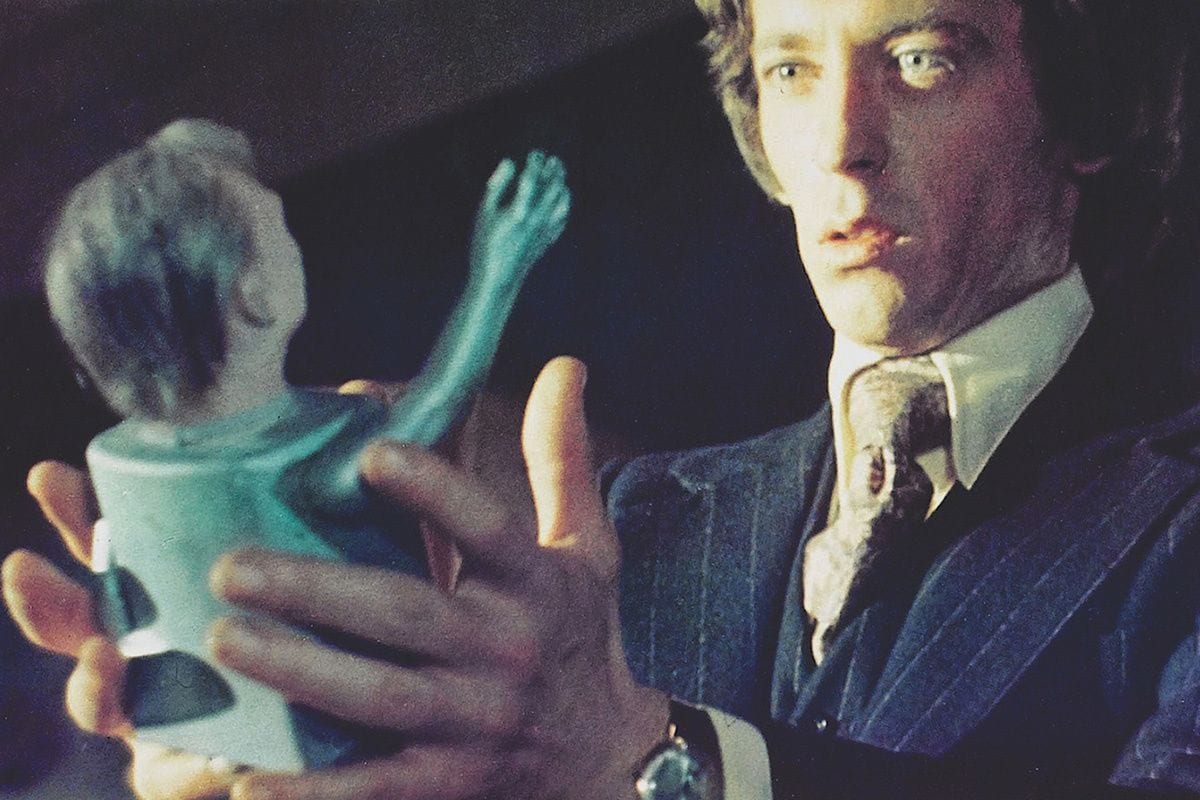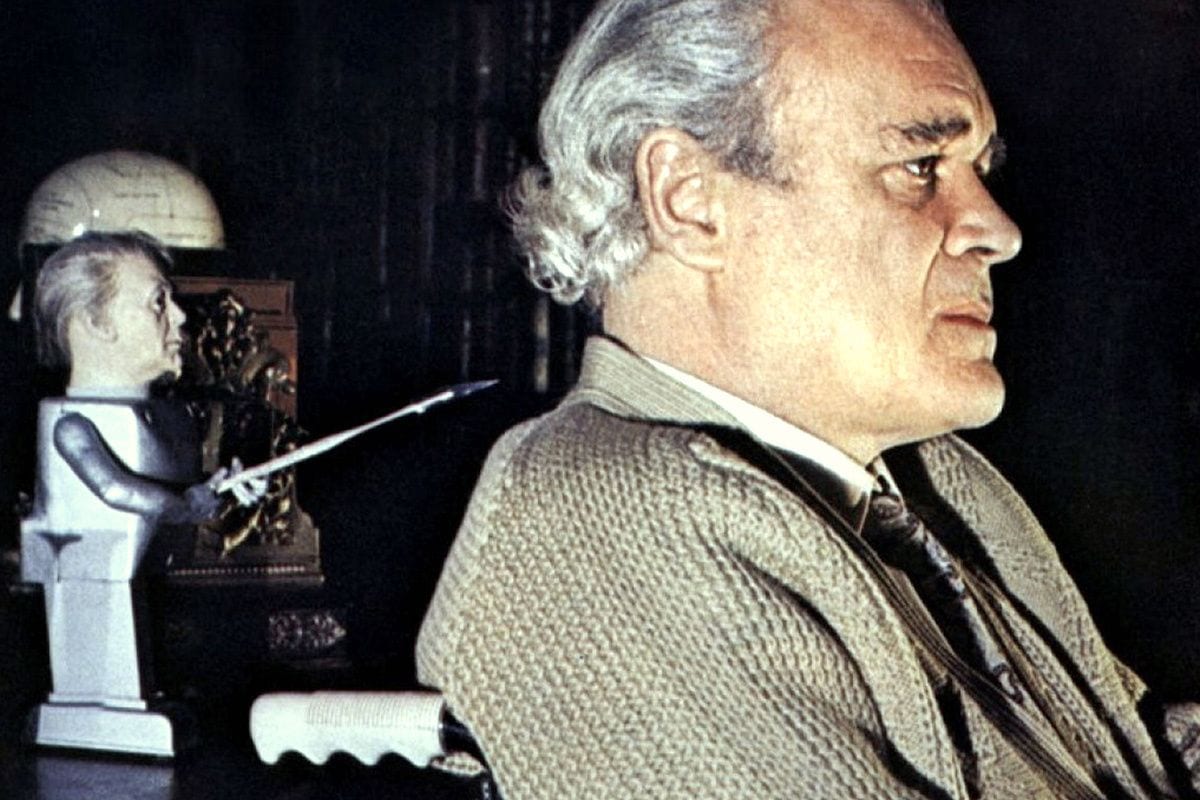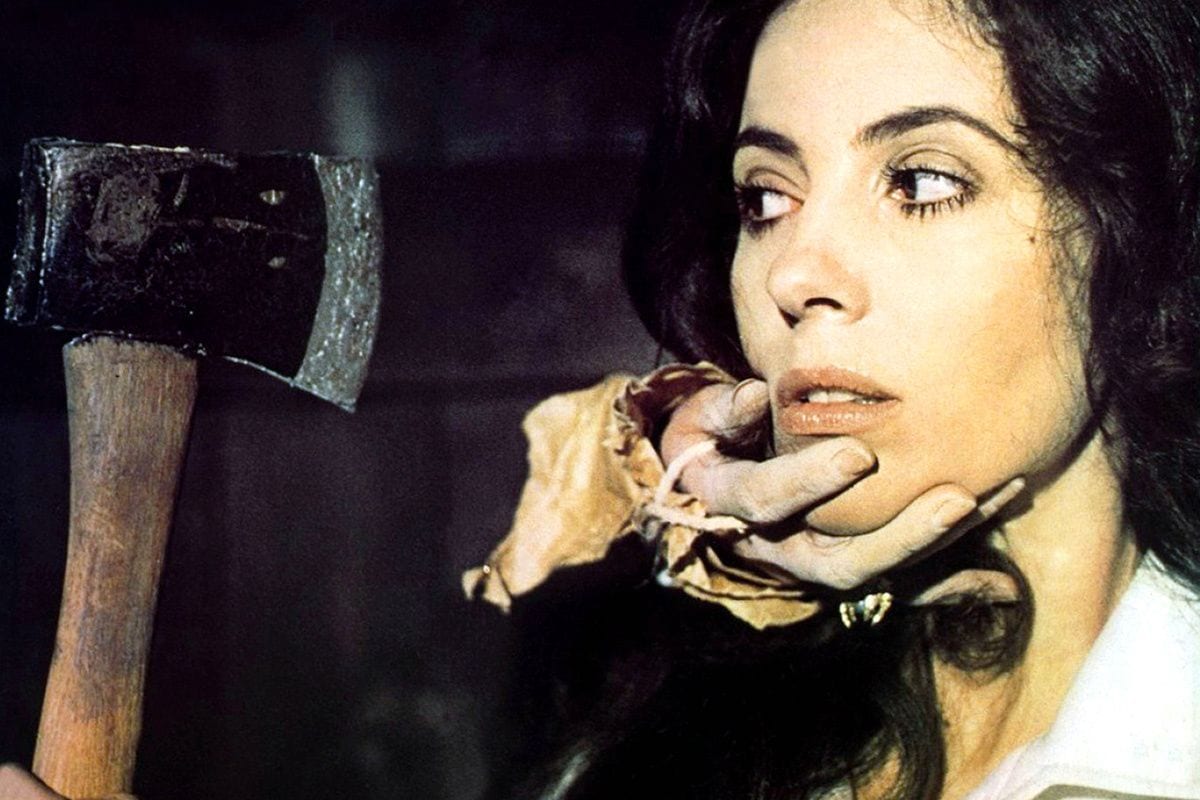

Portmanteau, or anthology horror films, are those genre entries that feature a number of distinct short stories that are strung together by a linking device. It’s a fun format that was initiated by Britain’s Ealing Studios when they released their multi-director effort The Dead of Night (Alberto Cavalcanti, Charles Crichton, Basil Dearden and Robert Hamer) in 1945. In that film the guests at a country house regale an architect – who appears to be stuck in a recurring nightmare – with a series of strange supernatural tales.
At the height of the British horror film boom that Hammer Films had initiated with The Curse of Frankenstein (Terence Fisher, 1957), another British company, Amicus Productions (which was actually run by two American managing directors, Milton Subotsky and Max J. Rosenberg), revived the portmanteau format with the highly popular Dr Terror’s House of Horrors (Freddie Francis, 1965). In this film five travellers who are sharing a train carriage each have the chilling nature of their future fates revealed by the Tarot card-reading Dr. Schreck (Peter Cushing).
Dr Terror’s House of Horrors was so successful that Amicus would return to the format time and time again. The company’s endeavours in this regard were also encouraged by the fact that jobbing big-name actors were happy to put in just a few days work for commensurate rates of pay so long as they received top billings in the films’ credits and promotional materials.
The short stories contained in these films typically end with a macabre twist in the tale, much like the stories that appeared in EC‘s demonized American horror comics during the 1950s. In fact, Amicus actually adapted some of EC’s stories and borrowed the comic book titles that they had mostly been drawn from for two of their most popular portmanteau horror films, Tales from the Crypt (Freddie Francis, 1972) and The Vault of Horror (Roy Ward Baker, 1973).
Tunnel by Dariusz Sankowski (Pixabay License / Pixabay)
For The House That Dripped Blood (Peter Duffell, 1971) and Asylum (Roy Ward Baker, 1972), Amicus employed the services of the horror author Robert Bloch, who had written the novel that Alfred Hitchcock’s Psycho (1960) was based on as well as providing stories for American “twist in the tale” themed TV shows such as Thriller (1960-1962), Alfred Hitchcock Presents (1955-1962) and The Alfred Hitchcock Hour (1962-1965).
Bloch worked on a number of films for Amicus – The Skull (Freddie Francis, 1965), The Psychopath (Freddie Francis, 1966) and The Deadly Bees (Freddie Francis, 1966) – before putting his first portmanteau effort together for them, Torture Garden (Freddie Francis), in 1967. In that film four adventurous thrill-seekers are enticed by Dr Diabolo’s (Burgess Meredith) fairground sideshow attractions before being offered the opportunity to have his mannequin of Atropos the goddess of destiny reveal the strange and terrifying nature of their future fates.
Amicus’ final portmanteau horror film was From Beyond the Grave (Kevin Connor, 1974). Featuring four stories based on the works of R. Chetwynd-Hayes, this superior example of the genre sees the four duplicitous customers who willfully steal from the humble owner of an antiques shop (Peter Cushing) each receiving visitations from the dangerous supernatural entities that are attached to their ill-gotten purchases. Amicus ceased producing films after the “lost world” adventure The People That Time Forgot (Kevin Connor, 1977) but Milton Subotsky would go on to produce three more portmanteau horror films: The Uncanny (Denis Heroux, 1977), The Monster Club (Roy Ward Baker, 1981) and Cat’s Eye (Lewis Teague, 1985).
The Uncanny has a writer, Wilbur (Peter Cushing), presenting three short stories in the form of case studies that are meant to convince his publisher, Frank Richards (Ray Milland), that cats are dangerous sentient creatures who are controlling the world in a manner entirely to their liking. In The Monster Club a vampire, Eramus (Vincent Price), takes the writer R. Chetwynd-Hayes (John Carradine) to a nightclub that is frequented by monsters and tells him three stories that are designed to assist him in differentiating between different types of monsters. Cat’s Eye presents three stories by Stephen King that are linked by the presence of a wandering alley cat.
Geoffrey Bayldon as Von Hartmann and Jon Pertwee as Paul Henderson in The House That Dripped Blood (courtesy of Second Sight Films)
The House That Dripped Blood
For its linking story, The House That Dripped Blood has Scotland Yard’s Inspector Holloway (John Bennett) visiting a quiet British country town in order to investigate the disappearance of a horror film actor, Paul Henderson (Jon Pertwee). When he visits the local police station, a concerned sergeant (John Malcolm) tells him two strange tales about the previous occupants of the old rural house that Paul was renting while shooting his latest film.
The first tale involves a horror story writer, Charles Hillyer (Denholm Elliott), who rents the house with his wife Alice (Joanna Dunham) in the hope that a change of scenery will ease his current bout of writer’s block. Charles is soon happily typing up a story about a deranged psychopath, Dominick, who roams the countryside looking for victims. However, serious problems arise when Charles – who also produces a detailed pencil drawing of his new antagonist for continued inspiration, a narrative device that is handily used to clue viewers in to what the monster looks like – starts seeing the sinister Dominick (Tom Adams) lurking around the house and its grounds with alarming regularity.
Is the dreaded killer just a figment of Charles’ imagination, or could he be real? This tale is a very effective psychological thriller that greatly benefits from the presence of an actor of Denholm Elliott’s calibre. Elliott is able to convincingly emote Charles’ state of mental distress, and the writer’s unfortunate predicament makes for a truly terrifying scenario.
In the second story, a newly retired businessman, Philip Grayson (Peter Cushing), rents the house and as he sorts through his possessions, he finds a photograph of a lady called Jane. It transpires that years earlier Philip, and his friend Neville Rogers (Joss Ackland), had both unsuccessfully tried to win Jane’s permanent affections. When Philip visits the Museum of Horrors in a nearby town, he is taken with a waxwork figure that brings Jane to mind. The museum’s proprietor (Wolfe Morris) duly warns him that the figure possesses the power to continually draw men back to her.
Philip fights the urge to return to the museum but complications arise when he receives an unexpected visit from Neville, who insists on visiting the self-same museum and is similarly taken by the waxwork figure. With memories of their old rivalry in love brought back to the fore, how will the two friends manage to deal with their new mutual obsession? This tale has more of a fantastical premise about it but solid acting turns from Peter Cushing and Joss Ackland assist the viewer in suspending their disbelief. There’s an effective and oppressive atmosphere generated in the museum scenes, thanks to some striking lighting, some good set designs, and some claustrophobic camerawork.
Peter Cushing as Philip Grayson in The House That Dripped Blood (courtesy of Second Sight Films)
Inspector Holloway is unimpressed by the sergeant’s stories about the house, and he elects to visit its letting agent, A. J. Stoker (John Bryans). However, Stoker has his own strange theories about the nature of the house, and he relates two further tales to Holloway. The first story sees an austere widower, John Reid (Christopher Lee), moving into the house with his small daughter, Jane (Chloe Franks). He employs a nanny-cum-teacher, Ann (Nyree Dawn Porter), to look after Jane as he doesn’t want the girl to have any contact with other children or the outside world. Ann determines that Reid hates his sweet but introverted daughter while also being afraid of her and she judges him to be a bullying, mean-spirited and uncaring father. But what could possibly make Reid so frightened of Jane?
Great acting wins the day, again. Christopher Lee is completely believable as the stern and quick-to-anger Reid while Nyree Dawn Porter hits the mark as the kindly teacher who naïvely takes the dynamics of the family’s father-daughter relationship at face value. But the story has secured a place in horror movie history as one of the most memorable portmanteau horror film episodes of all time thanks primarily to Chloe Franks’ highly nuanced performance for one so young, its highly original narrative, its perfect sense of pace and its really quite shocking finalé.
Stoker’s second tale relates directly to Paul Henderson, the missing actor that Holloway is searching for. It seems that all was not well on the set of the flamboyant actor’s latest horror film, which was being shot nearby. Scathing of the film’s low budget, the arrogant Henderson had clashed with its director, its set designer, its costume designer and his co-star Carla (Ingrid Pitt). So much so that he had decided to source his character’s black period cloak himself, purchasing one from a strange costumiers shop run by the sinister Von Hartmann (Geoffrey Bayldon). Stoker’s story suggests that the cloak is somehow responsible for Henderson’s disappearance, but Holloway is quick to dismiss his claims. The policeman duly travels to the house after dark, in spite of Stoker’s warnings, and he soon comes face-to-face with the house’s darkest secret.
Working in a slightly tongue-in-cheek manner, Jon Pertwee and Hammer Films’ star Ingrid Pitt have great fun sending up British horror films from the 1960s and early ’70s here. Henderson has a sly dig at Christopher Lee’s take on Dracula while his on-set argument with his director plays like a reference to the verbal sparring that is said to have taken place between Vincent Price and Michael Reeves on the set of Witchfinder General (1968). The fabulous Ingrid Pitt appears to be playing an exaggerated version of herself to all intents and purposes.
The House That Dripped Blood is a fine example of a horror film that works without being overly horrific. Director Peter Duffell hated the film’s title so much (he felt that Death and the Maiden would be a more appropriate title) that he took the liberty of ensuring that not one drop of blood was seen throughout the film’s entire runtime. His approach is a testament to the idea that implying horrific acts by having them take place off screen can sometimes be more effective than showing every gory detail.
The film’s set designs and thoughtful colour schemes are noticeably pleasing, and the house’s cluttered gothic interior is very impressive. However, most of the stories are brightly lit and thus possess little in the way of the truly spooky and gothic atmosphere that is more readily associated with films about old houses. That changes for the better during the film’s finalé when Holloway is forced to explore the house by candlelight after dark. Michael Dress’s adequate-if-at-times-unremarkable soundtrack score gets the job done in a reasonably effective manner. This is a low budget film, but its cast and crew were seasoned professionals who knew how to put an effective and decent looking movie together and the show is sure to please those with a liking for British horror films from the ’70s. The picture and sound quality of Second Sight Films’ new Region B Blu-ray of The House That Dripped Blood are both excellent.
Ingrid Pitt as Carla The House That Dripped Blood (courtesy of Second Sight Films)
Extra Features
The House That Dripped Blood is supported by a decent selection of extra features, chief of which is an interesting audio commentary with director Peter Duffell (moderated by Jonathan Rigby) that has been ported over from Anchor Bay UK’s 2003 DVD release of the film. A new audio commentary by Troy Howarth repeats some of the details proffered by Duffell in the earlier commentary whilst offering more in terms of the actors’ backgrounds, the film’s production history and the like. A recent interview with the film’s assistant director Mike Higgins provides a number of interesting anecdotes. ‘A–Rated Horror Film’ is a superb mini documentary led by Peter Duffell, with contributions from Geoffrey Bayldon, Ingrid Pitt and Chloe Franks, which also appeared on Anchor Bay’s earlier DVD. Two trailers, a selection of radio spots for a number of Amicus films and a pleasing image gallery round out the disc-based extra features. The actual release is advertised as coming in a hard slipcase with a poster and a booklet but these items were not provided for review.

Asylum
For its linking story, Asylum has Dr. Martin (Robert Powell) travelling to a remote mental institution in order to be interviewed for the job of Senior Houseman. The asylum’s stand-in manager, Dr. Rutherford (Patrick Magee), advises him that his senior colleague, Dr. B. Starr, recently attacked him after suffering a psychotic episode and he is consequently being treated as a patient. Starr is calm and rational now, but a new personality has taken over him, one that possesses its own name and its own life story.
Martin is to interview four of the institution’s patients who are all suffering from the same condition and if he can determine which of them is Starr he will be considered to be qualified for the job. He is accompanied in his quest by an orderly, Max Reynolds (Geoffrey Bayldon), who has been instructed not to impart any pertinent information to him.
This opening portion of the film successfully sets Asylum‘s tone and aesthetic look, which are both somewhat darker than those of The House That Dripped Blood. Rain is pouring down and mist swirls around the grounds of the imposing, gothic-styled institution as Martin approaches it, while cinematographer Denys Coop generates a palpable sense of dread by shooting the asylum from an assortment of threatening angles. When Martin enters the building, its interior is revealed to be gloomy, soulless, and cold. Dramatic sections of Modest Mussorgsky’s classical pieces ‘Night on Bald Mountain’ and ‘Pictures at an Exhibition’ are put to very good use on the soundtrack and greatly help to add an impressively doom-laden edge to the film’s introductory section.
The first patient that Martin interviews is a female called ‘Bonnie’ (Barbara Parkins). Bonnie tells a story in which she cooks up a macabre plan for her married lover Walter (Richard Todd) to do away with his rich wife, Ruth (Sylvia Syms). However, Ruth seems unconcerned by any potential threats as she is convinced that the protective charm that was given to her by a spiritual leader, who has been teaching her the ancient arts, will protect her from malicious acts. Is Ruth right to have such faith in the charm’s powers?
Robert Powell as Dr Martin in Asylum (courtesy of Second Sight Films)
Bonnie’s tale has a rather grim narrative but the presence of British acting royalty in the form of Richard Todd and Sylvia Syms, and director Roy Ward Baker’s restrained and classy approach, prevents the proceedings from becoming anything like those seen in contemporaneous exploitation films. Ruth’s revenge is novel to say the least and results in one or two extremely effective jump scares. Set predominantly in Walter and Ruth’s home, this is a tale of domestic terror that also features some pretty modish-if-garish examples of early ’70s interior decorating styles.
The second patient that Martin interviews is a man called ‘Bruno’ (Barry Morse). Bruno declares that he has always been a tailor and he tells Martin the story of the night that a gentleman called Mr. Smith (Peter Cushing) called into his shop. Smith wants a special suit making as a surprise for his son. He provides a roll of iridescent material that is unlike anything that Bruno has ever seen before. He also gives Bruno his son’s measurements, diagrams showing the suit’s style and a schedule that demands that the suit is only worked on after midnight. It will be an arduous task, but Bruno and his wife Anna (Ann Firbank) are due to be evicted from their premises unless they pay their rent within the week. As such, Bruno has no choice but to take the job on. But what is the true nature of the strange cloth and what possible use would anyone have for a suit made out of it?
If you like short horror stories that are truly bizarre but nonetheless pleasingly inventive, this tale will likely be the highlight of the film for you. Its finalé is superb. And there are some atmospheric bits of business to be had when Bruno visits Smith’s grand but dilapidated home in order to complete their deal. Peter Cushing excels here, playing a mysterious character who will do anything to possess the strange suit and Barry Morse and Ann Firbank are convincing as the desperate couple who must do his bidding to keep a roof over their heads.
The third patient that Martin interviews is a female called ‘Barbara’ (Charlotte Rampling). Barbara tells a story about the day that she returned home to her brother George’s (James Villiers) house following a previous stay in a sanatorium. She’s alarmed to discover that George has employed a nurse, Miss Higgins (Megs Jenkins), to watch over her. Prior to her hospitalisation, Barbara had been popping pills and getting into all kinds of trouble with her best friend, Lucy (Britt Ekland). Barbara starts secretly popping the pills again, and Lucy soon turns up with a plan that will allow her to escape from George and Miss Higgins.
This tale is effectively a good and convincingly acted psychological thriller that keeps the viewer guessing as to whether Lucy really exists or not. However, it necessarily possesses a more nuanced and subtle approach while utilising a more measured pace when compared to the film’s previous two stories, which means that it perhaps doesn’t make quite as much of an impression on first viewing. Writer Robert Bloch had apparently presented the film’s four stories in an order that saw an incremental increase in their intensity and in that arrangement Barbara’s tale was positioned first. However, Amicus’ co-managing director Max J. Rosenberg had insisted that a high-intensity story should open the film in order to grab the viewer’s attention. It might well be that Bloch’s running order would have worked slightly better.
Patrick Magee as Dr Rutherford in Asylum (courtesy of Second Sight Films)
The fourth patient that Martin interviews is a man called ‘Byron’ (Herbert Lom). Byron professes to be a physician, a neurosurgeon and an orthopaedic specialist whose ideas and theories have progressed beyond the understandings of his peers. He shows Martin the doll-like creations (they have seemingly robotic bodies and human-like heads) that he has been working on and he claims that just as soon as he is able to will his own consciousness into one of them, Dr. Rutherford will be punished.
Byron doesn’t relate a past story as such, but he does go on to play a part in the film’s finalé when he takes his experiments with his latest creation to the next level and sets out for revenge. In the midst of the chaos that ensues, Martin finally discovers the identity of Dr. Starr in what is, without doubt, the most disturbing final payoff ever to grace an Amicus portmanteau horror film. Excerpts of Modest Mussorgsky’s striking classical pieces are used again during the film’s finalé to great dramatic and atmospheric effect.
Most of Amicus’ portmanteau horror films feature impressive rosters of acting talent who are eminently well-cast and Asylum might well be the company’s best effort in this regard. Everybody here turns in convincing performances. The film’s linking story benefits greatly from the assured presence of Robert Powell, Patrick Magee, Geoffrey Bayldon and Herbert Lom. The final segment featuring Byron is probably the film’s most fantastical section, but Herbert Lom does an amazing job that assists the viewer in suspending their disbelief. Much like the slightly better-known Patrick Magee, Geoffrey Bayldon remains something of a cult actor and he pretty much steals the show here with his nuanced performance as the orderly Reynolds.
Seasoned director Roy Ward Baker had made a few well-regarded horror films for Hammer prior to directing Asylum and this experience is well utilised here. Baker and his crew do a fine job of cooking up a series of macabre thrills and atmospheric chills in this show.
Douglas Gamley’s expressive and dramatic soundtrack score deserves a special mention as it is pretty much pitch-perfect throughout. Much of his original music takes its stylistic cues from the repurposed Mussorgsky pieces used during Asylum‘s introductory scene and it all works to add much in the way of atmosphere to the film’s horrific proceedings. The picture and sound quality of Second Sight Films’ new Region B Blu-ray of Asylum doesn’t fare quite as well as their presentation of The House That Dripped Blood. Asylum‘s picture quality is very good overall, but the quality of the film’s sound remains a little thin in places.
Barbara Parkins as Bonnie in Asylum (courtesy of Second Sight Films)
Extra Features
Asylum is supported by a decent selection of extra features, chief of which is an interesting audio commentary with director Roy Ward Baker and camera operator Neil Binney (moderated by Marcus Hearn) that has been ported over from Anchor Bay UK’s 2003 DVD release of the film. ‘Two’s A Company’ (a pun on the fact that Amicus was essentially a two-man show run by Subotsky and Rosenberg) is a fascinating on-set report shot by the BBC that will thrill anybody with an interest in Amicus, Asylum, British horror films of the period and filmmaking more generally. It features contributions from Subotsky, director Roy Ward Baker, editor Peter Tanner, art director Tony Curtis, production manager Teresa Bolland and the actors Charlotte Rampling, James Villiers and Megs Jenkins. ‘Inside the Fear Factory’ is an interesting documentary that loosely covers the evolution of Amicus Productions and features contributions from Max J. Rosenberg, Roy Ward Baker and Freddie Francis (this extra feature also appeared on Anchor Bay’s earlier DVD).
A more recent extra feature has David J. Schow offering a comprehensive account of author Robert Bloch’s career while also discussing the origins of the stories that made it into Asylum, how they differed to what eventually appeared in the finished film and Bloch’s working relationship with Subotsky and Rosenberg. Another equally recent extra feature has Subotsky’s widow Fiona offering some charming memories of her husband’s cultural interests, his work in the film industry, the regular casts and crews that Amicus employed, his relationship with Rosenberg and so on. A trailer rounds out the disc-based extra features. The actual release is advertised as coming in a hard slipcase with a poster and a booklet but these items were not provided for review.

By today’s standards, The House That Dripped Blood and Asylum are both quaint and quirky and their horror content is reasonably tame. However, for fans of British horror films from the 1960s and early ’70s, and fans of the actors that appear in them, these two portmanteau horror films are already established favourites. Both films feature fine casts, compelling narratives, and good technical aspects. Asylum probably has a slight edge over The House That Dripped Blood simply because its linking story is more plausible and convincing and its short stories are on balance more consistent and pleasingly creative. In addition, Asylum possesses a generally darker ambience that is successfully employed to a slightly more chilling effect.



